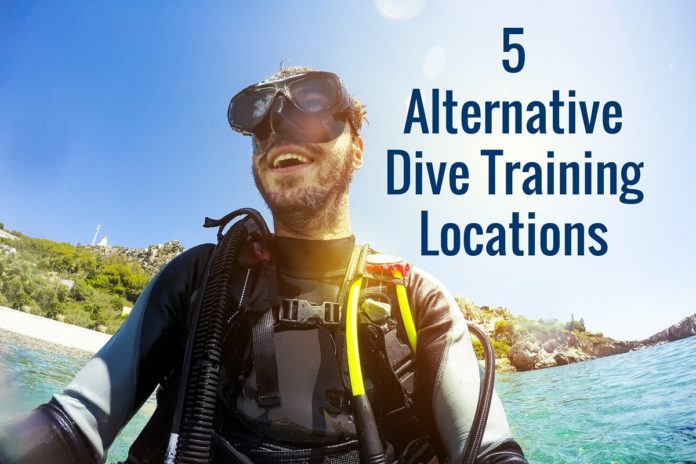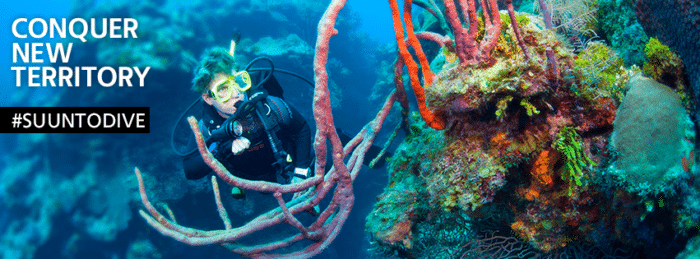Thailand, Mexico, Egypt, Australia, and Indonesia are just some of the most popular places in the world for dive training. However, there’s a host of alternate locations that divers are flocking to before the secret gets out…
Colombia
It’s no secret that diving in the Caribbean is pretty much as good as it can get, anywhere. But whilst most divers put Barbados, the Bahamas and the British Virgin Islands top their bucket list, it’s little known that Colombia has some of the most accessible dive spots in the whole region.
The coral island of San Andrés, just 50km (30miles) off the coast of mainland Columbia, has recently seen a huge surge in popularity amongst divers who are taking advantage of low prices, typical 30m (100ft) visibility, and the year-round warm water temperatures which mean wet suits are optional.
Diving is wide-ranging – from drop-offs and drift dives to wrecks – but the island is most popular amongst course students (from Open Water to Instructor training) for its shore diving. Many sites offer walk-in/walk-out diving so students simply wake up in their beach-side bungalow, eat breakfast on the beach, and then stroll straight into the blue.
Tonga
Tonga isn’t the first place to spring to mind when it comes to paradise in the South Pacific. Most tourists prefer to flock to Tahiti, French Polynesia and the Cook Islands where the diving is as good as the blindingly white sand beaches and umbrella-clad cocktails.
However, whilst not as luxurious or as opulent as much of South Pacific’s more well-known honeymoon hot spots, the 176 islands that make up Tonga are up there with the best of them when it comes to diving.
The tiny country’s numerous dive sites (which are still be discovered) are known for their huge variation – from hot spring caverns to deep wrecks and giant arches. Most also boast untouched coral reefs that support a diverse marine ecosystem ranging from macro life to pelagic giants, and everything in between. What’s more, Tonga is a recognized breeding ground for calving humpbacks and is one of the only places in the world where you can swim with these majestic whales. It’s not uncommon for mid-dive sightings during the season that runs from July through to October.
New Zealand
Divers head Down Under to undertake training in Australia for good reason. Locations including the Great Barrier Reef, Rottnest Island, and Byron Bay provide some of the world’s best diving, as well as first-class tuition. However, just across the ‘ditch’, New Zealand offers a whole different experience.
Its location – pretty much as far away from the rest of the world as possible – and colder, sometimes tough conditions mean that New Zealand’s dive industry is more limited than its famed neighbors. However, those who take training courses here are both challenged and rewarded, massively: don’t expect anything less than world-class wrecks, pristine sub-tropical reefs and some of the most diverse marine life anywhere in the southern hemisphere.
If you need a second opinion, Jacques Cousteau once said that Poor Knights Island marine reserve, off New Zealand’s Bay of Islands, was one of his top five dive sites anywhere in the world.
Malta
Europe is often overlooked when it comes to diving but those who have dived there argue fervently that the Mediterranean, and specifically Malta, has it all.
Looking for shallow reefs to build your dive experience? No problem. Ready to step up and experience your first submarine cave or five-knot drift dive? You’ve got it. Want to dive deep and search for wrecks? Malta’s got them in abundance too.
From beginner favorites to advanced technical sites, Malta’s clear blue waters – lying just 80km (50miles) south of Italy – offer an array of diving to rival any, meaning you’re hard pushed to find a better alternative to start or continue your next diver training adventure.
Tanzania
Tanzania is known for picture-perfect safaris across the Serengeti but for divers, another huge draw-card comes in the form of the Indian Ocean.
Just a couple of hours by boat from the mainland, the island of Zanzibar and its surrounding atolls are encircled by warm turquoise waters that are, in turn, flanked by deep ocean currents. The mix creates a tropical paradise for divers.
Marine diversity ranges from the endemic Zanzibar butterflyfish to some 13 species of shark. Huge schools of fish also help ensure every dive is as jaw-dropping as the previous one so diving trainees have plenty to keep them occupied.
Brought To You By
This guide is brought to you by Suunto. We recommend that you use a Suunto Dive Computer when diving one of these dive sites. Suunto is the world’s leading dive computer designer and manufacturer providing diving instruments for recreational, technical and freediving. You can find out more at Suunto.com.


